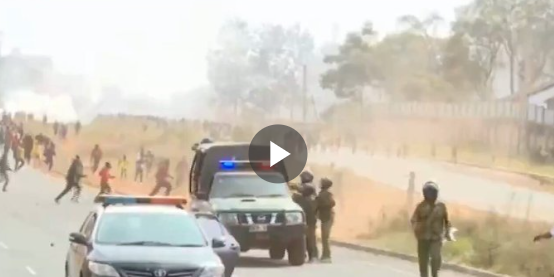It was just weeks ago when Kenya was the darling of the West. Such high hopes western powers had in the budding African nation. Well, times change fast these days.
Kenyan police have used tear gas in Nairobi and Mombasa to break up anti-government protests. These demonstrations, which have also spread to other cities such as Kisumu, began two weeks ago in response to a controversial finance bill. Since then, 39 people have reportedly been killed by security forces. Although President William Ruto has since withdrawn the proposed tax increases, the protests have shifted focus, now calling for his resignation and condemning police brutality.
BREAKING: Protesters are overpowering the police in Kenya’s Kangemi region. Police are forced to retreat despite deploying massive amounts of tear gas. Anti-government protests erupted this morning, calling for President William Ruto’s resignation.#OccupyCBDTuesday #Maandamano pic.twitter.com/mYCSFPox9N
— red. (@redstreamnet) July 2, 2024
The scale of the current demonstrations is smaller than last week’s, but there have been chaotic scenes, particularly in Mombasa, where cars were set on fire as protesters clashed with police. In Nairobi, there is a heavy security presence, with running battles occurring along major roads. Protesters have lit fires and thrown stones at the police. In the central business districts of both cities, some shop owners have hired vigilantes to protect their properties from looting.
Astin Kibowen, a 21-year-old guarding the music shop where he works in Nairobi, expressed his frustration, saying he wanted the president “to listen to our cries, to our voices.” Since President Ruto took office two years ago with promises to revitalize the economy, Kenyans have faced a cost-of-living crisis, exacerbated by increased taxes on salaries, fuel, and gross sales.
Cops fire tear gas at protestors demanding President Ruto resignation
Riot police fired tear gas and charged at stone-throwing protesters in Nairobi and across Kenya amid the most widespread unrest since at least two dozen protesters died last week.
The demonstrations signaled… pic.twitter.com/aMAmpOZzPQ
— 𝕏 𝐁𝐫𝐞𝐚𝐤𝐢𝐧𝐠 𝐍𝐞𝐰𝐬 (@cheguwera) July 2, 2024
On one of Nairobi’s main streets, activists placed empty coffins in front of riot police to highlight the excessive use of force during the protests. The Kenya National Commission on Human Rights (KNCHR), a state-funded organization, reported that most protesters were killed last Tuesday when MPs passed the finance bill and large crowds gathered to demonstrate. According to KNCHR, 17 people died in Nairobi, and 22 others were killed in other parts of the country. Additionally, there have been 361 injuries, 32 cases of “enforced or involuntary disappearances,” and 627 arrests.
Amnesty International reported that 24 protesters had died, while police figures placed the death toll at 19. An artist in Nairobi, Linda Indakwa, 29, is documenting the protests through her art. “We are mourning the children killed by police. As others chant, I’m doing art,” she said, pointing to a piece where she depicted a flag draped over a man shot last week.
The KNCHR condemned the “unwarranted violence and force inflicted on protesters, medical personnel, lawyers, journalists, and on safe spaces such as churches, medical emergency centers, and ambulances,” describing the police response as “excessive and disproportionate.”
Riot police fired tear gas grenades at protesters in Nairobi as violence returned to the streets of Kenya’s capital after young activists called for more demonstrations following a week of deadly clashes https://t.co/7HVeyk8cql pic.twitter.com/NBaFp72YRz
— Reuters (@Reuters) July 2, 2024
In a roundtable interview with journalists, President Ruto defended the police, stating they had “done the best they could.” He acknowledged that any excesses would be addressed through “existing mechanisms.” The president also highlighted the financial repercussions of rejecting the finance bill, stating that Kenya would need to borrow one trillion shillings ($7.6 billion; £6.1 billion) to run the government, a 67% increase from planned borrowing. This borrowing would impact key sectors such as education, health, and agriculture.
Major Points:
- Kenyan police used tear gas to disperse anti-government protests in Nairobi and Mombasa, which began in response to a controversial finance bill.
- President William Ruto has withdrawn the proposed tax increases, but the protests have shifted to demands for his resignation and condemnation of police brutality.
- Human rights organizations report that 39 people have been killed by security forces since the protests began, with many more injured and arrested.
- Protesters in Nairobi placed empty coffins in front of riot police to highlight the excessive use of force during the demonstrations.
- President Ruto defended the police’s actions, stating they did their best, and emphasized the financial necessity of the withdrawn finance bill, warning of increased borrowing needs.
Al Santana – Reprinted with permission of Whatfinger News



